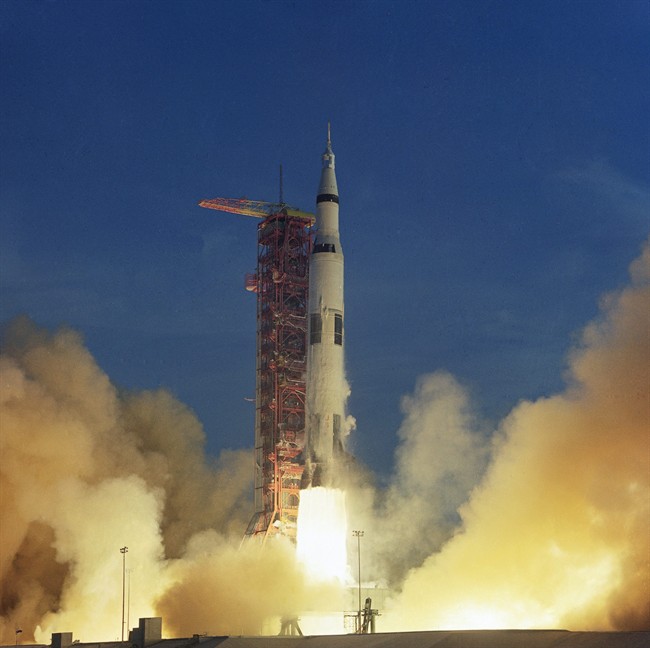CAPE CANAVERAL, Fla. – SpaceX has aborted a planned rocket launch from NASA‘s historic moon pad. It is now delayed 24 hours.

As the sun rose Saturday over Kennedy Space Center in Florida, the unmanned Falcon rocket stood at Launch Complex 39A, ready to soar. Liftoff is scheduled for 10:01 a.m.
SpaceX was planning to send up a load of space station supplies from the exact spot where Americans flew to the moon almost a half-century ago. The pad was last used in 2011 for NASA’s final space shuttle flight.
This was to be SpaceX’s first launch from Florida since a rocket explosion Sept. 1. The accident during prelaunch testing heavily damaged that pad. SpaceX turned to Launch Complex 39A – which it leases from NASA – to resume flights. The company hopes to launch astronauts from 39A next year. They also launched a rocket from California in January.

“I can tell you it’s an extra special launch …. maybe extra nerve-wracking,” SpaceX President Gwynne Shotwell told reporters Friday just outside the pad fencing.
Here’s a brief rundown on historic Launch Complex 39A at Kennedy Space Center:
- High benzene levels detected near Ontario First Nation for weeks, residents report sickness
- Meta says you can’t turn off its new AI tool on Facebook, Instagram
- Enter at your own risk: New home security camera aims paintballs at intruders
- Beijing orders Apple to pull WhatsApp, Threads from its China app store
___
BIG BEGINNINGS
NASA built 39A, as it’s commonly known, in the mid-1960s for the monstrous Saturn V moon rockets. It was first used in 1967 for an unmanned test flight, followed by another early the next year. Next came the astronauts, with Apollo 8 soaring to the moon right before Christmas 1968. SpaceX chief Elon Musk noted late last week via Instagram, “We are honoured to be allowed to use it.”
READ MORE: SpaceX plan to fuel rockets with people aboard raises eyebrows
___
SHOWSTOPPING ACTS
The crescendo came on July 16, 1969, as Apollo 11’s Neil Armstrong, Buzz Aldrin and Michael Collins embarked on the first manned moon landing. All six Apollo moon-landings originated from here, as did close-call Apollo 13. Columbia made the first space shuttle flight from this pad on April 12, 1981, while Atlantis closed out the program from the same spot on July 8, 2011.
READ MORE: UAE joins race to Mars, aims to build 1st city on red planet by 2117
___
FREQUENT FLIER
This will be the 95th rocket launch from 39A. It was the departure point for 82 space shuttle flights and 11 Apollo missions, as well as the unmanned 1973 launch of Skylab, NASA’s original space station. One flight resulted in casualties. As Columbia lifted off on Jan. 16, 2003, foam insulation from the external fuel tank broke off and gouged the left wing. Columbia and its crew were lost 16 days later during re-entry.
READ MORE: Elon Musk reveals bold plans to colonize Mars
___
SPACEX TAKEOVER
SpaceX signed a 20-year lease with NASA in 2014, beating out another tech billionaire’s rocket company, Jeff Bezos’ Blue Origin. Renovation work was accelerated after SpaceX’s Sept. 1 rocket explosion a few miles away at Launch Complex 40 on Air Force property. The accident occurred during fueling for a prelaunch test. It is from pad 39A that SpaceX plans to launch Falcon rockets with space station-bound astronauts for NASA as early as next year. The company also might send spacecraft and, ultimately, crews to Mars from this location as well. “What an awesome use of a great American asset,” Kennedy Space Center’s director, Robert Cabana, said Friday. Without the lease agreement, “this pad would have just sat here and rusted away in the salt air.”
READ MORE: SpaceX launches first rocket since September explosion
___
LESSER-KNOWN TWIN
Just a mile to the north, Launch Complex 39B is the lesser-known, lesser-used twin. Apollo 10 christened 39B in 1969. In the shuttle era, Challenger inaugurated the pad on Jan. 28, 1986. The doomed flight with schoolteacher Christa McAuliffe lasted 73 seconds. In all, 53 shuttle missions began from this pad, for a total of 59 launches of all types. It was last used in 2009 for an unmanned test flight of NASA’s Ares rocket, cancelled soon afterward. NASA is transforming 39B for its yet-to-fly Space Launch System megarocket, intended to send astronauts beyond low-Earth orbit.
READ MORE: History of SpaceX: 10 milestones and hurdles the space company has faced
___



Comments